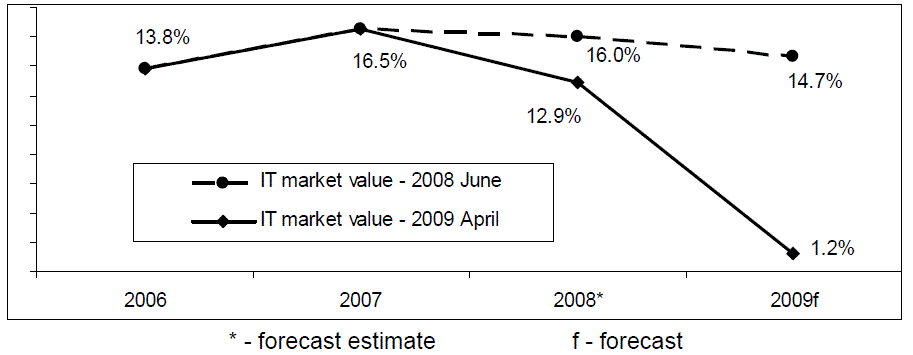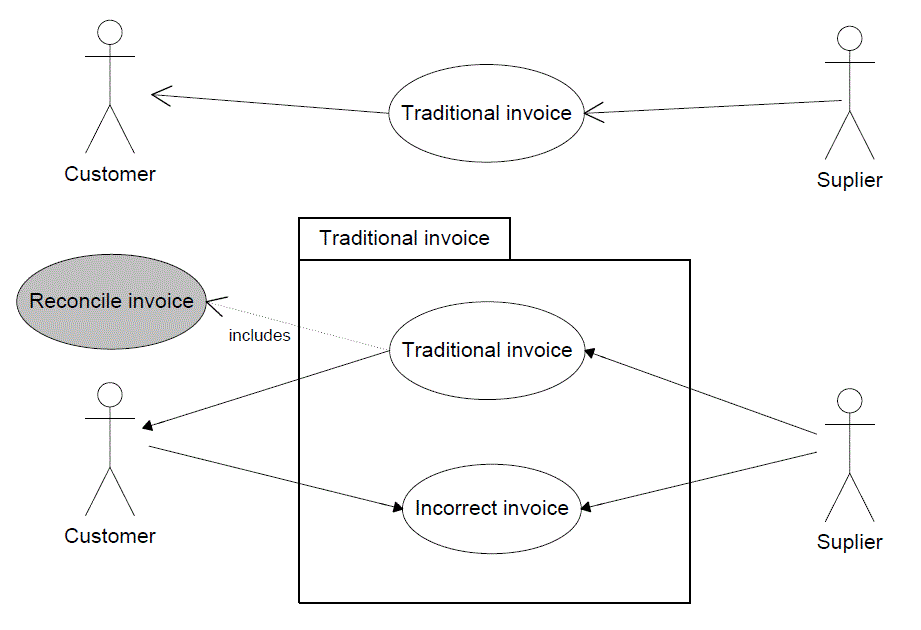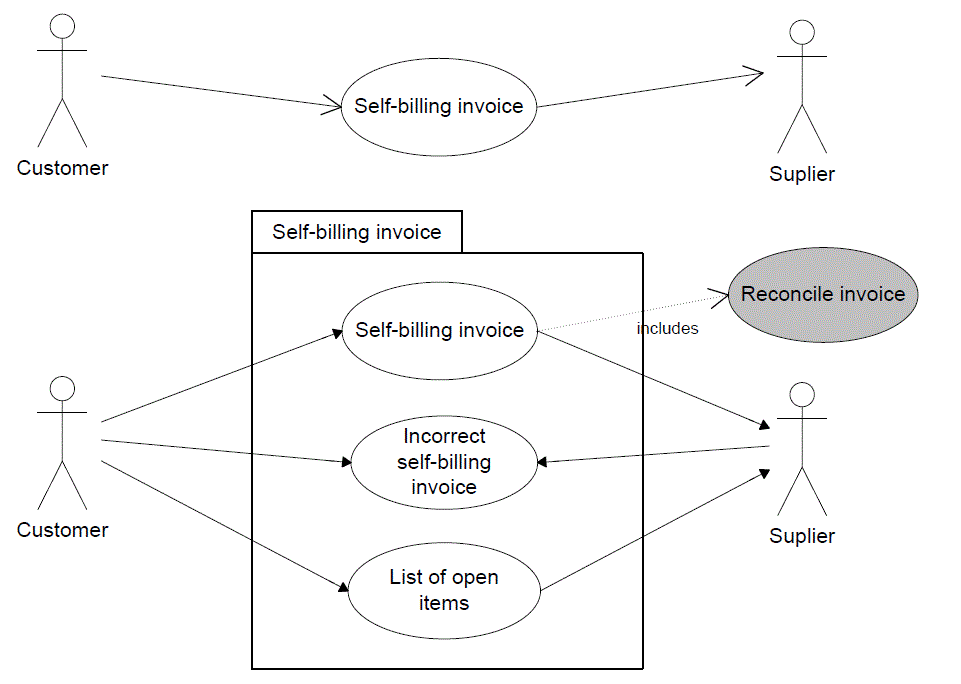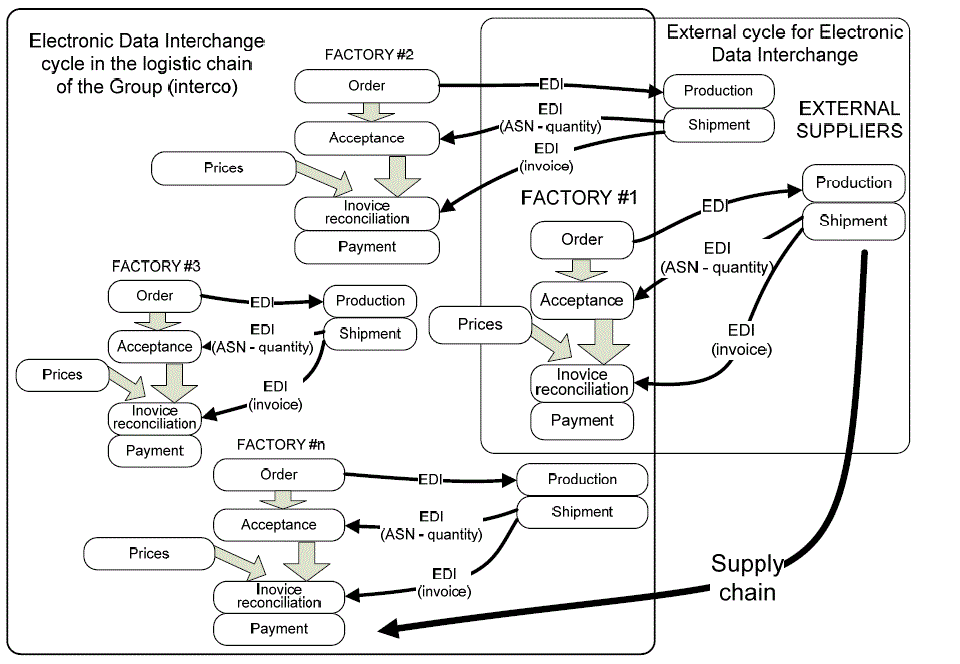Keywords
|
| economic effectiveness; automated settlement system for a supply chain; invoicing, self-invoicing, Electronic Data Interchange (EDI) technologies implementation; case study; Poland |
INTRODUCTION
|
| The global financial crisis, which affected the Polish economy in the second half of 2008, resulted in deteriorating economic situation of numerous companies and institutions. Persuasive evidence is provided by: national statistics, economic and social analyses, and by monitoring changes in economic tendencies. Implications of the crisis were observed in information technology domain, too. Clear signals came from producers and providers of IT products and services, and from their customers. They were also acknowledged by nearly all major companies monitoring IT industry, including: DiS, Gartner, Forrester Research, IDG or PMR, which issued revised market forecasts in 2009. The report of PMR, entitled „Revision of forecasts for IT markets in Poland, Russia and Ukraine” (Olszynka 2009a), (presented in figures 1), may serve as the example. |
| The similar conclusions resulted from the research conducted by the author of this paper in April-May 2009. The author surveyed 139 companies and analysed collected data with respect to possible influence of the economic crisis on IT strategies and projects (Dyczkowski 2009, Dyczkowski 2010). The examination showed that in 58.27% of companies the economic crisis affected negatively their financial situation, and in 6.47% such deterioration was substantial. In most of cases this implied partial (55.4% of the poll) and in some (7.91%) even radical changes in informatisation strategies. A positive correlation between the worsening economic situation and a scope of changes in IT strategies was detected, as well. The surveyed companies mentioned such symptoms of changes as: decreasing spendings related to IT investments (48.86%), reduced budgets (38.64%) staff redundancies in IT departments (23.86%), postponing already planned IT investments (32.95%), streamlining IT costs (25%), abandoning new or cutting ongoing IT projects (21.59% each). |
| The similar symptoms referring to financial and operational aspects of IT are observed currently. This results in more and more frequent activities aiming at optimising Total Cost of Ownership (TCO) on the one hand, and increasing impact of IT on improving corporate performance, on the other one. |
| If implemented projects, focused on improving effectiveness of IT applications, are to generate expected results, they should reflect methodology of IT effectiveness management presented in the literature and successfully applied in business practice (Benson, Bugnitz and Walton 2004, Orzechowski 2009). Such solutions which increase impact of IT applications on improving corporate performance by the same of even lower level of expenditure/cost are particularly welcome (Kauremaa 2010). |
| Before effectiveness-related issues are discussed, the following chapter will briefly characterise problems of automating settlements in a logistic chain of the automotive industry. This industry, particularly struck by the economic distress, has to intensify its proeffective activities, including the IT area, more than any other. |
Automated settlements in logistic chains of the automotive industry
|
| The Automotive industry is characterised by the well developed co-operation in production and logistics. This results in intensive information exchange within internal and expanded supply chains and in mass financial settlements. Tens of thousands of documents, expressing conducted transactions in quantitative measures and in value, are exchanged and settled by a single company each year. This includes an array of documents issued when a transaction is proceeded, starting from initial orders, and finishing with invoices and payments. The basic documents related to quantity and a range of contracted products have been successively replaced by electronic messages of EDI systems since 1970s. Such standards as EDIFACT, Odette or VDA prevails in this area. Much later – due to the necessity of developing and harmonising on an cross-industrial and international levels (e.g. BRS UN/CEFACT TBG1 2008, CEN CWA 15668 2007) and, ultimately, reflecting in tax and accounting legislation and standards (A Study on the Invoicing Directive… 2008, Tentszert 2009) – the EDI messages in logistics could be supplemented by financial settlements, including invoicing (CEN CWA Fiscalis 2008, Korus, Swierczynski 2007). This enabled to close the electronic settlements cycle and, consequently, to automate it. With regard to automation the two basic invoicing models: a traditional and a self-billing one should be considered. |
| The traditional invoicing process is initiated by a supplier. An invoice is issued alongside a shipment or when a shipment is accepted by a buyer. If any variance between an invoice and an actual shipment is detected or delivered goods are returned to the supplier, a buyer demands correcting invoice or issues a debit note before the payment proceeds. Such a correcting invoice or a debit note may be used for settling past changes in price, as well. The use case diagram for the traditional invoicing is presented in figure 2. |
| The self-billing invoicing process is organised the opposite way. It is initiated by buyers, who debit themselves on a behalf of suppliers with a reference to a history of orders, agreed prices and actual shipments. Only the goods accepted by a buyer are reflected in the invoice. If the supplier notices variances (in product specification, quantity or value), they are obliged to issue a claim. The buyer revises the claim and issues a correcting invoice or a debit note in a form of another self-billing invoice. The past price changes are settled the same way. The use case diagram for self-billing invoices is presented in figure 3. |
| The most important difference between the two models is that the latter transfers responsibility for (and knowledge about) future payments on buyers. They may, therefore, estimate necessary reserves and manage their cash flow more accurately. The automotive sector pioneered such solutions in early 1990s due to circumstances referred to at the beginning of this chapter. On its initiative the first consistent standards of data transmission, such as the German VDA4908, were developed. This standard describes the settlement process and presents technical specification for formats of EDI messages. The mechanism for settlement has basically remained unchanged since that time. Only data formats have evolved. In fact, this process has become the industrial standard, what is reflected, on the one hand, in final buyers’ requirements toward settlement methods, and on the other one, in integrating automated accounting functionalities in nearly all ERP systems dedicated to the automotive companies (e.g. EDI 2009, Faurecia 2009). |
| The self-billing settlements meet numerous organisational and legal obstacles, starting from limited scope of allowed operations, through rigorous tax treatment, to partial or complete ban on their use. In case of cross-border operations, what is typical for the automotive sector, the settlement process is becoming complicated, what reduces scope of its use or results in emerging local versions. The EC directive on invoicing, in force since January 2004, was to solve that problem on the Common European Market. Unfortunately, an interpretation of the directive, and elaborating on open issues, was delegated to the Member States. That resulted in developing several groups of solutions, with their local versions, which differ in many respects. |
| The essential differences include: registering self-billing agreements in tax offices, requirements related to consent of parties involved, allowed transmission media, necessity of keeping supplementary paper documents, and procedures for keeping file copies (A Study on the Invoicing Directive… 2008). In Germany, for example, self-billing agreements do not have to be registered, single invoices may be transmitted in a form of EDI messages and they do not have to be stored in original formats. Only global (cumulative) invoices are required in a paper form. In Poland, on the contrary, registration is mandatory and must be renewed by both parties every year. Invoices must not be sent as EDI messages, as they should either be issued in paper form or as qualified electronic invoices. They must be stored in their original formats, as well (Rybok 2009, 12). These limitations make companies operating in countries where self-billing is constrained search for other models to automate their settlement processes. |
| The example for such a solution, called EDI cycle closure, is demonstrated in figure 4. Originally, only orders and shipments were transmitted as EDI messages (ASN – Advanced Shipment Note). In addition, each shipment was followed by a paper order reception, and invoices where periodically sent to an accounting department of a buyer by ordinary post. The existing procedure to acknowledge reception: “accept only what was ordered” does not permit to register a shipment that was not preceded by an order. The accounting system may operate analogically. The procedure is as follows: “pay only for what was accepted, if the invoice is as planned”. To achieve that electronic invoices, sent for information purposes only, must be implemented. In that case strict formal requirements do not apply (Tentszert 2009). The adequate level of price compliance is necessary, as well. This way automated accounting procedures may be created and applied. While the legal nature of liabilities in a logistic chain remains unchanged, the registration process may be accelerated significantly, due to reducing human involvement in the most time-consuming operations. |
| The following chapter will present an evaluation of economic effectiveness for a project involving automated settlement system based on the concept of EDI cycle closure. |
Evaluating economic effectiveness in a project of an automated settlement system
|
The basic characteristics of the project
|
| The analysed project (see Rybok 2009) is carried out by a financial centre of an international automotive company, located in Poland. The centre, set up in 2008, took over financial support for six business entities, belonging to the group, operating in the Polish market. If the project, involving consolidation of financial support, proves to be successful, its further expansion is planned. It should, eventually, include business units operating in neighbouring countries (i.e. 34 production plants belonging to the group and located in Central and Eastern Europe). The operations conducted by the financial centre include: |
| • establishing and implementing accounting procedures in compliance with nationwide and international accounting and reporting standards, |
| • co-ordinating month-end closing operations, with special attention paid to internal group settlements (the so-called „interco” settlements, see figure 4), |
| • managing receivables, liabilities, cash flows, fixed assets and taxes on the behalf and for the benefit of the supported business entities. |
| The scope of the project and, consequently, expected benefits, can be described by the following figures: |
| • the number of invoices settled annually (over 62,000 in 2008, and over 65,000 in 2009), |
| • high cost of the invoicing process (it amounted to 320,000 PLN in 2008 – i.e. ~80,000 EUR, with increasing unit cost of 5.20 PLN – i.e. ~1.3 EUR in 2008), |
| • significant time and workload required to conduct the process (in 2008 an average time for registering a correct invoice was equal to 3 minutes, and in case of correcting invoices it reached 15 minutes, what gave over 1070 person-days in total, where 700 referred to correcting invoices – the so-called price compliance factor was equal to 73.2%). |
| The technical side of the project involved: |
| • modifying functionalities in ERP systems supporting purchase and sales, |
| • incorporating a two-way conversion (mapping) algorithm between VDA and EDIFACT formats to the EDI message broker, so that the final exchange protocol would not affect the ERP system itself, |
| • developing and implementing such functionalities as: integrating EDI invoices and their cumulated transmission in given cycles (nightly, weekly, monthly etc.), automated invoice registration (based on shipment acceptance and price compliance), manual exception processing (e.g. price variances), and periodical reporting on settlement processes. |
| The project is carried out by a team consisting of representatives of an internal competence centre developing the corporate ERP system, business key users, IT specialists, employees of a financial support centre and external contractors for selected services (information broker with a VDA/EDIFACT conversion algorithm and automated accounting mechanism). |
Methodological foundations for the evaluation
|
| The examination was conducted assuming that: |
| • the expenditure and all the costs related to the implemented solutions can be qualified as technological, and therefore they may be attributed to particular elements of the IT systems, |
| • all the benefits affecting business performance, resulting from optimising processes, may be identified and measured. |
| This is a simplified scenario, as, on the one hand, automated mode should facilitate incident handling (lower cost of IT support for the users), but, on the other one, additional cost resulting from initial decrease in efficiency – resulting from adjusting to new working methods – should be expected. These factors were not considered when the project was initiated, and thus they may be excluded from the analysis. |
| The automated settlement process is the direct expected benefit of the project. It is reflected by reduced time spent on manual operations. Setting up night cycles of data processing and registering, without human involvement, allows to reduce workload dedicated to registering correct documents down to zero. An ergonomic design of error handling, in such a way that their reasons do not have to be identified in various points of the ERP system, gives additional time saving for a single operation by tenfold. The expected share of OK operations (correct registration) and ERR ones (registration with price variance) is represented by the level of price compliance ratio, calculated for each supplier when the new registration mode is set. |
| The evaluation employed methods which proved to be effective in investment calculations, and which are more and more frequent in IT area, based on cost-benefits analysis (CBA) algorithms. The basic effectiveness measures, used to calculate an absolute profitability of the project, derived from recommendation for commercial European projects. They included dynamic financial measures such as net present value (NPV), internal rate of return (IRR) and modified IRR (MIRR) (for detailed description see CypryjaÃâ¦Ãâski 2007, Dudycz, Dyczkowski 2006 and Lech 2007). |
Results obtained and their interpretation
|
| The table 2 presents investment expenditure and operating cost for the analysed project, followed by the cash flow. This information enabled to calculate effectiveness measures for the period of 3 years: NPV = 551,788.02 PLN (~137,947.01 EUR), IRR = 194.78% and MIRR = 159.71% (!). These values prove, beyond any doubt, that the project meets absolute profitability criteria, and therefore it is economically effective. |
| The scope of potential benefits resulting from the project confirms expectation of qualitative changes in the settlement processes. It should be noticed, though, that the estimates are rough, due to many uncertainty factors and lack of reliable points of reference. On the other hand, the literature gives examples from the automotive industry where comparable scope of improvement was reported. For example, Mukhopadhyay, Kekre and Kalathur (1995) estimated the savings from Chrysler’s use of EDI with its suppliers and improved information exchanges for 60 USD per vehicle (see also Dyczkowski 2008, where a similar project is described). |
| To conclude the effectiveness evaluation, it should be added that a supplementary sensitivity analysis for the described project proved that price compliance ratio is a critical success factor for this undertaking. This means that data quality is of the highest importance here. |
Conclusion
|
| The pilot start of the project took place in May 2009, as scheduled. The price compliance ratios for the three initiated data streams reached nearly 90%. This is particularly significant, as in one case the initial level of price compliance was equal to 7% only. This proved the proper recognition of price compliance as the critical success factor. It demonstrated also that low quality of data can be effectively dealt with, and it should not be treated as the risk factor any more. All data required for settling receivables and liabilities were reconciled on the third day after the month-end closing for May. The situation when information on invoices for purchase were available in buyer’s accounting systems before actual shipments were delivered could be observed for the first time in companies’ history. The EDI transmissions were set up for night cycles, and therefore preceded registration of shipments based on ASN documents timed by transport slots. |
| The project helped also to build sound relations between the financial support centre and the IT department and external IT contractors, based on mutual benefits. This may be treated as a secondary effect of the project for now, but could become the major benefit if future IT project are taken into consideration. This is particularly important, as an effective co-operation between core business and IT domains guarantees successful implementation of solutions aiming at increasing IT contribution to performance of companies or institutions. |
| |
Tables at a glance
|
 |
 |
| Table 1 |
Table 2 |
|
| |
Figures at a glance
|
 |
 |
 |
 |
| Figure 1 |
Figure 2 |
Figure 3 |
Figure 4 |
|
| |
References
|
- A Study on the Invoicing Directive (2001/115/EC) now incorporated into the VAT Directive (2006/112/EC) prepared by PricewaterhouseCoopers. Final Report 3 November 2008.Tender no. TAXUD/2007/AO-009.
- Benson, R., Bugnitz, T., Walton, W. (2004). From Business Strategy to IT Action. Right Decision for the Better Bottom Line. John Wiley & Sons, New Jersey.
- BRS UN/CEFACT TBG1 (2008). Business requirements specification – Cross industry invoicing process. UN/CEFACT International Trade and Business Processes Group TBG1, ver.2.00.05, rel. 2.
- CEN CWA 15668 (2007). Business requirements specification – Cross industry invoicingprocess. European Committee for Standardization, Brussels.
- CEN CWA Fiscalis (2008). CEN/Fiscalis e-Invoicing Good Practices Guidelines. Interim CEN Workshop Agreement, ver. 3.01. European Committee for Standardization, Brussels.
- Cypryjanski, J. (2007). Methodological foundations for economic evaluation of IT investments incompanies. University of Szczecin Scientific Publishing House, Szczecin 2007, „Theses and studies” series, volume 669 (in Polish).
- Dudycz, H., Dyczkowski, M. (2006). Effectiveness of IT projects. Methodological foundations for evaluation and exemplary applications. Publishing House of the University of Economics,Wroclaw (in Polish).
- Dyczkowski, M. (2008). Economic effectiveness evaluation in a project of information technologychange on the example of order processing system. Advanced Information Technologiesfor Management AITM’2008. J. Korczak, H. Dudycz, M. Dyczkowski, eds. WroclawUniversity of Economics Research Papers, 35, 67-78.
- Dyczkowski, M. (2009). Economic crisis and informatisation strategies of enterprises. Results of a survey with a focus on SME sector. Advanced Information Technologies for Management AITM’2009. J. Korczak, H. Dudycz, M. Dyczkowski, eds. Wroclaw University of Economics Research Papers, 85, 77-95.
- Dyczkowski M. (2010). Economic crisis and IT strategies of enterprises in Poland. Results of a survey with a focus on Polish SME sector. Proceedings of the 3rd International Conference for Entrepreneurs, Innovation and Regional Development – ICEIRD 2010. Z. Anisic, ed. University of Novi Sad, Faculty of Technical Sciences, Department of Industrial Engineering and Management, Novi Sad 2010, 227-234.
- EDI (2009) Implementation Guidelines. Logistic processes. VOLKSWAGEN AG, ver. August 2009.
- Faurecia (2009). Customer self-billing risk assessment. Faurecia Core Procedure FAU-F-LSG- 3540.
- Kauremaa, J. (2010). Studies on the utilization of electronic trading systems in supply chain management. Helsinki University of Technology, Department of Industrial Engineering and Management, Doctoral Dissertation Series 2010/10, Espoo.
- Korus, K., Swierczynski, M. (2007). Electronic invoices – legal issues. e-Biuletyn 1/2007. The Centre for Legal and Economic Studies on Electronic Communication. Faculty of Law, Administration and Economics, University of Wroclaw, Wroclaw (in Polish).
- Lech, P. (2007). Methodology for economic evaluation of IT projects supporting corporatemanagement. The Publishing House of the University of Gdansk, Gdansk (in Polish).
- Mukhopadhyay, T., Kekre, S., Kalathur, S. (1995) Business value of information technology: a study of electronic data interchange. MIS Quarterly, 19:2, June, 137-156.
- Olszynka, P. (2009). Revision of forecasts for IT markets in Poland, Russia and Ukraine. Free article based on IT market in Poland 2008. Development forecasts 2008-2012 – Update.
- Impact of the crisis on key data and forecasts. PMR Publications April, www.itandtelecompoland.com.
- Orzechowski, R. (2008). Building corporate value with IT. Warsaw School of Economics, Warsaw (in Polish).
- Rybok, P. (2009). Evaluating effectiveness of IT investments. Case study of the Financial Centre for FAURECIA Group. The thesis supervised by M. Dyczkowski. Postgraduate Study in Effective IT Business Management, 6th edition. Warsaw School of Economics, Warsaw (manuscript in Polish).
- Tentszert, K. (2009). Self-billing. [in:] Transactions in the Common European Market – Value Added Tax Act.2nd edition. L. Mazur, E. Sokolowska, eds. Practical Comments on Taxation, C.H. Beck Publishing, Warsaw (in Polish).
|